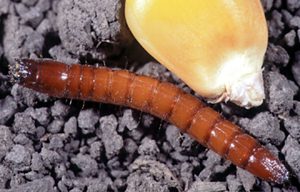Q. I hope you can help me. I like to plant a garden. My problem is my potatoes. They develop holes in them later on in their development. These holes are about a quarter-inch in size and about a quarter-inch deep. I don’t find bugs or anything else on them, so maybe it is the soil.
I have rotated my crops, have tried different kinds of potatoes and, last year, and tried a kind that was scab resistant. The scab-resistant ones didn’t seem as bad as the others but still had some holes. I always buy certified seed potatoes, and we use some dry cattle manure for fertilizer. The potatoes are still usable, but I would like to know how to correct my problem. Any suggestions would be appreciated.
A. It is difficult to make a conclusive diagnosis from the description alone, but wireworms would be high on my suspect list. Wireworms, the larvae of click beetles, are about three-fourths to 1 1/2 inches long and yellow-brown in color. Wireworms are more problematic in gardens that were previously in lawn, pasture or weedy areas. Wireworm larvae can live as long as five years, or more!

Wireworm larvae
(photo credit: John Obermeyer/Purdue Entomology)
Wireworms are not very discriminating; their damage is most noticeable on root crops such as potatoes, turnips, radishes, sweet potatoes and carrots, but they also feed on the seeds of corn, beans, and peas and roots of other crops such as cabbage, melons, cucumbers and tomato, causing reduced vigor and sometimes killing the plants.
There are currently no insecticides that are effective for control of wireworms in the home garden. In most gardens, the damage from wireworms is relatively minor. Keeping weeds and lawn grass out of the garden area is the best strategy, but it can take quite a few years for the population to subside since they have such a long life cycle. As you’ve noted, you can cut away the affected portions on root crops and consume the rest. But if you are consistently seeing wireworm damage every year and/or the percentage of damage is high, you might consider rotating to a different garden, raised bed or container garden using clean soil.
Q. Could you let us know what causes white spots under the skin of tomatoes? Is there a way of preventing it?
A. White spots under the skin of the tomato could be caused by a number of factors, including weather conditions, insect pests or plant disease. So the control or prevention strategies depend on accurate diagnosis.
Feeding by stink bugs results in cloudy white or yellow blotches in the tissue just under the skin, usually a bit spongy or corky in texture.
Similar internal white tissue can be seen with a physiological disorder called yellow shoulder, which is associated with adverse weather, poor nutrition and/or high soil pH.
Some diseases such as bacterial speck and bacterial spot can result in yellowish or whitish spots on the outside of the fruit and are more likely to occur in wet weather or in gardens that have overhead irrigation.
Bacterial canker disease causes tiny black spots on the outside of the skin accompanied by whitish halos and is a very serious, non-treatable disease of tomatoes. Plants with this disease should be pulled from the garden and should NOT be composted.
If you continue to see these symptoms in your tomato patch, you need to get an accurate diagnosis. You can bring samples of your plants to Purdue Extension office in your county. See the county directory for contact information. Or, you can submit a sample to the Purdue Plant and Pest Diagnostic Lab either by live sample or digital images.